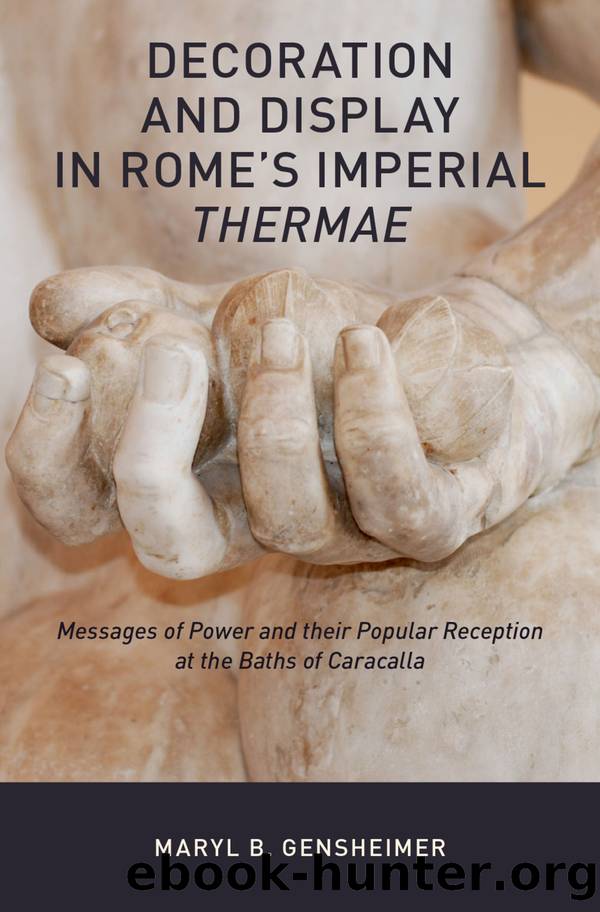Decoration and Display in Rome's Imperial Thermae by Maryl B. Gensheimer;

Author:Maryl B. Gensheimer;
Language: eng
Format: epub
Publisher: OUP Premium
Published: 2018-06-15T00:00:00+00:00
The Severans and Associations with North Africa
The Severan building program in Romeâparticularly the new construction utilizing or emphasizing an aquatic componentâcan be understood in the context of establishing and affirming Severan legitimacy and the divine right to rule. The question still remains why, precisely, this particular zone of the city was chosen for such ambitious construction. On a related note, it is important to consider why Caracalla would have chosen to endow his own eponymous baths in the same district that his father had previously built upon.
This area of the city abutting the Palatine Hill, the Porta Capena, and the Via Appia was free for dynastic building on a monumental scale. Focused building here by Severus and his architects could and would profoundly transform this area of the city in a manner analogous to earlier dynastic building programs. Augustus and the Julio-Claudians, for instance, focused a great deal of their patronage in the area of the Campus Martius.53 Similarly, the Flavians had embellished the land formerly occupied by Neroâs Domus Aurea (c. 64â68 c.e.), both in the valley between the Palatine and Esquiline and on the hills themselves.54 In his concentration on this district south of the Palatine, Severus was following imperial precedent; by choosing a distinct area of the city for his own building program, Severus adeptly claimed this area as his own. But why would this area, in particular, have been chosen? Why not some other neighborhood? Severusâ attention to a single area of the city of Rome is not unusual, but the precise choice of the district favored with his patronage is quite noteworthy.
In terms of purely practical considerations, one should note that this neighborhood offered both open construction space and an audience for Severusâ projects. In the immediate area, there is evidence for wealthy private homes, like the Hadrianic-period house later embedded in the platform of the Baths of Caracalla55 or the house given by Septimius Severus to L. Fabius Cilo, the urban prefect, in 203 c.e.56 The homes on the Aventine Hill could also be served by Severusâ baths and nymphaeum, as could visitors arriving from the south on the Via Appia. Moreover, various urban cohorts, such as the Castra Peregrina and the stationes of the fourth and fifth cohorts of vigiles, were stationed at barracks just to the east of the Via Appia and presumably also were served by Severusâ projects.57 In functional terms, therefore, there was a ready constituency for an infrastructure program in this area of the city. The requisite supplies, such as wood for the furnaces of Severusâ baths, also could be easily provided via either the Via Appia or (after its completion) the newly constructed Via Nova.
There are, of course, also ideological explanations that underlie Severan building in this area of the city. According to the Historia Augusta, the Septizodium was deliberately situated at the end of the Via Appia and oriented such that it faced visitors arriving to Rome from Africa. The Historia Augusta goes on to report that
Download
This site does not store any files on its server. We only index and link to content provided by other sites. Please contact the content providers to delete copyright contents if any and email us, we'll remove relevant links or contents immediately.
The European History Highway: A Guide to Internet Resources by Dennis A. Trinkle Scott A. Merriman(498)
The Seven Wonders of the Ancient World by Michael Denis Higgins(479)
European Security in a Global Context by Thierry Tardy(472)
European Security without the Soviet Union by Stuart Croft Phil Williams(472)
The Routledge companion to Christian ethics by D. Stephen Long Rebekah L. Miles(461)
Hudud Al-'Alam 'The Regions of the World' - a Persian Geography 372 A.H. (982 AD) by V. V. Minorsky & C. E. Bosworth(402)
Gorbachev And His Generals by William C. Green(393)
Get Real with Storytime by Julie Dietzel-Glair & Marianne Crandall Follis(391)
Tibetan Studies in Comparative Perspective by Chih-yu Shih Yu-Wen Chen(387)
Governance, Growth and Global Leadership by Espen Moe(385)
Hyperculture by Byung-Chul Han(382)
CliffsNotes on Fitzgerald's The Great Gatsby by Kate Maurer(363)
The Oxford History of the World by Fernández-Armesto Felipe;(357)
How Languages Are Learned 5th Edition by Patsy M Lightbown;Nina Spada; & Nina Spada(355)
The Egyptian Economy, 1952-2000 by Khalid Ikram(355)
Oral Poetry and Narratives from Central Arabia: The Poetry of Ad-Dindan : A Bedouin Bard in Southern Najd (Studies in Arabic Literature, Vol 17) (English and Arabic Edition) by P. M. Kupershoek P. Marcel Kurpershoek(345)
The Oxford Handbook of the Incas by Sonia Alconini(336)
Europe Contested by Harold James(323)
The Hutchinson Dictionary of Ancient and Medieval Warfare by Peter Connolly John Gillingham John Lazenby(308)
